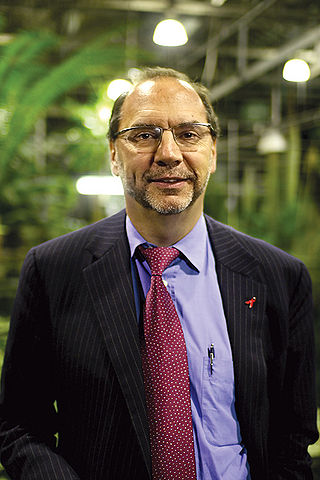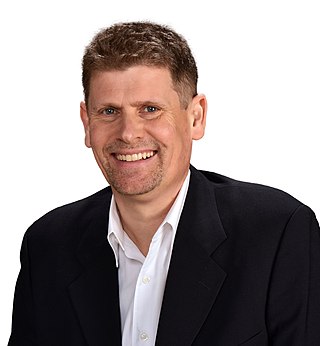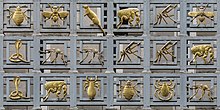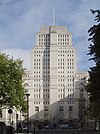
Sir Ronald Ross was a British medical doctor who received the Nobel Prize for Physiology or Medicine in 1902 for his work on the transmission of malaria, becoming the first British Nobel laureate, and the first born outside Europe. His discovery of the malarial parasite in the gastrointestinal tract of a mosquito in 1897 proved that malaria was transmitted by mosquitoes, and laid the foundation for the method of combating the disease.

Sir Peter Karel, Baron Piot, is a Belgian-British microbiologist known for his research into Ebola and AIDS.

The Liverpool School of Tropical Medicine (LSTM) is a higher education institution with degree awarding powers and registered charity located in Liverpool, United Kingdom. Established in 1898, it was the first institution in the world dedicated to research and teaching in tropical medicine. The school has a research portfolio of over £220 million, assisted by funding from organisations such as the Bill & Melinda Gates Foundation, Wellcome Trust and Department for International Development (DFID).

Tropical medicine is an interdisciplinary branch of medicine that deals with health issues that occur uniquely, are more widespread, or are more difficult to control in tropical and subtropical regions.

Nagasaki University is a national university of Japan. Its nickname is Chōdai (長大). The main campus is located in Bunkyo-machi, Nagasaki City, Nagasaki Prefecture, Japan.
David L. Heymann is an American infectious disease epidemiologist and public health expert, based in London.

The Tulane School of Public Health and Tropical Medicine is part of Tulane University, located in New Orleans, in the U.S. state of Louisiana.

Sir Alimuddin Zumla,, FRCP, FRCPath, FRSB is a British-Zambian professor of infectious diseases and international health at University College London Medical School. He specialises in infectious and tropical diseases, clinical immunology, and internal medicine, with a special interest in HIV/AIDS, respiratory infections, and diseases of poverty. He is known for his leadership of infectious/tropical diseases research and capacity development activities. He was awarded a Knighthood in the 2017 Queens Birthday Honours list for services to public health and protection from infectious disease. In 2012, he was awarded Zambia's highest civilian honour, the Order of the Grand Commander of Distinguished services - First Division. In 2023, for the sixth consecutive year, Zumla was recognised by Clarivate Analytics, Web of Science as one of the world's top 1% most cited researchers. In 2021 Sir Zumla was elected as Fellow of The World Academy of Sciences.

Vikram Harshad Patel FMedSci is an Indian psychiatrist and researcher best known for his work on child development and mental disability in low-resource settings. He is the Co-Founder and former Director of the Centre for Global Mental Health at the London School of Hygiene and Tropical Medicine (LSHTM), Co-Director of the Centre for Control of Chronic Conditions at the Public Health Foundation of India, and the Co-Founder of Sangath, an Indian NGO dedicated to research in the areas of child development, adolescent health and mental health. Since 2024, he has been the Paul Farmer Professor and Chair of the Department of Global Health and Social Medicine at Harvard Medical School in Boston, where he was previously the Pershing Square Professor of Global Health and Social Medicine. He was awarded a Wellcome Trust Principal Research Fellowship in 2015. In April 2015, he was listed as one of the world's 100 most influential people by TIME magazine.

John Payne Woodall (1935–2016), known as Jack Woodall, was an American-British entomologist and virologist who made significant contributions to the study of arboviruses in South America, the Caribbean and Africa. He did research on the causative agents of dengue fever, Crimean–Congo hemorrhagic fever, o'nyong'nyong fever, yellow fever, Zika fever, and others.
Richard Iwa Idro is a Ugandan pediatric neurologist, researcher and academic, who serves as an associate professor in the Department of Pediatrics and Child Health at Makerere University College of Health Sciences.
Eleanor Mary Riley was Director of the Roslin Institute, Dean of Research at the Royal (Dick) School of Veterinary Studies, and professor of Immunology at the University of Edinburgh. Her research focusses on understanding the immune response of the host to malaria and other diseases using human data and mouse models.

Sir Christopher John MacRae Whitty is a British epidemiologist, serving as Chief Medical Officer for England and Chief Medical Adviser to the UK Government since 2019.
Elizabeth Lucy Corbett is a British epidemiologist who is Professor of Tropical Epidemiology at the London School of Hygiene & Tropical Medicine. Her research investigates the regulation of tuberculosis in HIV prevalent populations and improving access to HIV self-testing.
Azra Catherine Hilary Ghani is a British epidemiologist who is a professor of Infectious Disease Epidemiology at Imperial College London. Her research considers the mathematical modelling of infectious diseases, including malaria, bovine spongiform encephalopathy and coronavirus. She has worked with the World Health Organization on their technical strategy for malaria. She is associate director of the MRC Centre for Global Infectious Disease Analysis.
Maria DeJoseph Van Kerkhove is an American infectious disease epidemiologist. With a background in high-threat pathogens, Van Kerkhove specializes in emerging and re-emerging infectious diseases and is based in the Health Emergencies Program at the World Health Organization (WHO). She is the technical lead of COVID-19 response and the head of emerging diseases and zoonosis unit at WHO.

John Andrew Crump MB ChB, MD, DTM&H, FRACP, FRCPA, FRCP is a New Zealand-born infectious diseases physician, medical microbiologist, and epidemiologist. He is Professor of Medicine, Pathology, and Global Health at the University of Otago and an adjunct professor of medicine, Pathology, and Global Health at Duke University. He served as inaugural co-director of the Otago Global Health Institute, one of the university's research centres. His primary research interest is fever in the tropics, focusing on invasive bacterial diseases and bacterial zoonoses.
Claire Elizabeth Bayntun is an English physician specialised in global public health, director of Global Leadership Programmes, assistant professor at the London School of Hygiene & Tropical Medicine, advisor on health security and health protection, and trained mentor who coaches health leaders. She is vice-president of the Royal Society of Medicine, London.
Fred Newton Binka is a public health physician and researcher from Ghana. He serves as a distinguished professor of clinical epidemiology at the University of Health and Allied Sciences (UHAS) in Ho, Ghana, and has previously coordinated the World Health Organization (WHO) Emergency Response to Artemisinin Resistance in the Greater Mekong sub-region of Asia. He is the founding vice-chancellor of UHAS and the former executive secretary of the INDEPTH Network, a global network of health and demographic surveillance systems. His work in malaria control and health development in Africa, particularly in the areas of vitamin A supplementation, insecticide-treated bed nets, and rotavirus and meningitis vaccination, has been impactful.
Joel Breman was an American epidemiologist. He led efforts to control ebola, guinea worm, malaria, measles, onchocerciasis, polio, smallpox, and other infectious diseases.

































